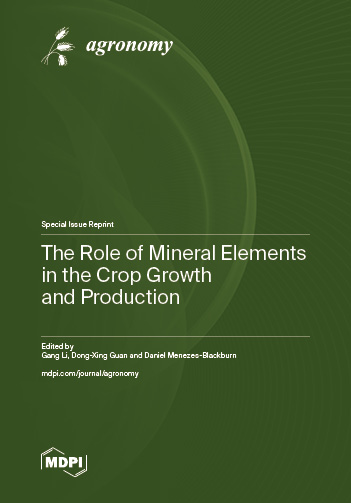The Role of Mineral Elements in the Crop Growth and Production
A special issue of Agronomy (ISSN 2073-4395). This special issue belongs to the section "Soil and Plant Nutrition".
Deadline for manuscript submissions: closed (15 June 2023) | Viewed by 28787
Special Issue Editors
Interests: mineral nutrition of crop; plant-soil-microbe interaction
Interests: soil contamination and remediation; passive sampling; chemical imaging; soil-plant interaction; contaminant and nutrient bioavailability; food safety; soil health
Special Issues, Collections and Topics in MDPI journals
Interests: soil microbiology, rhizosphere science, plant nutrition, soil phosphorus and sulfur, soil salinity
Special Issues, Collections and Topics in MDPI journals
Special Issue Information
Dear Colleagues,
Mineral elements, including macro- and micronutrients, have multiple biological functions in the whole life cycle of crops. The growth, production, and quality of crops and their fruits are indispensable from mineral elements, especially the balance in their bioavailable quantities in soils. In recent years, sustainable agriculture has become an important issue in realizing the UN’s Sustainable Development Goals. Keeping the balance of mineral elements and increasing the bioavailability of mineral elements such as phosphorus (P) and trace elements in agricultural production will be pivotal for sustainable agriculture. This Special Issue is therefore inviting contributions of articles for publication, focusing on (1) how mineral elements (macro nutrient: S, Ca, Mg, K, P, N; trace elements: Fe, Mn, Cu, Zn, Se Mo, Ni, Se; beneficial element: Si) affect the growth, production, and quality of crops; (2) bioavailability and dynamics of chemical and microbial processes of mineral elements in the crop rhizosphere; and (3) interaction between mineral elements in soil–crop systems from microcosm to ecosystem scales.
All submissions will be peer-reviewed according to the high standards of the journal. Once accepted, the article will be published online and accessible to the research community regardless of when the Special Issue is available in print.
Dr. Gang Li
Dr. Dong-Xing Guan
Dr. Daniel Menezes-Blackburn
Guest Editors
Manuscript Submission Information
Manuscripts should be submitted online at www.mdpi.com by registering and logging in to this website. Once you are registered, click here to go to the submission form. Manuscripts can be submitted until the deadline. All submissions that pass pre-check are peer-reviewed. Accepted papers will be published continuously in the journal (as soon as accepted) and will be listed together on the special issue website. Research articles, review articles as well as short communications are invited. For planned papers, a title and short abstract (about 100 words) can be sent to the Editorial Office for announcement on this website.
Submitted manuscripts should not have been published previously, nor be under consideration for publication elsewhere (except conference proceedings papers). All manuscripts are thoroughly refereed through a single-blind peer-review process. A guide for authors and other relevant information for submission of manuscripts is available on the Instructions for Authors page. Agronomy is an international peer-reviewed open access monthly journal published by MDPI.
Please visit the Instructions for Authors page before submitting a manuscript. The Article Processing Charge (APC) for publication in this open access journal is 2600 CHF (Swiss Francs). Submitted papers should be well formatted and use good English. Authors may use MDPI's English editing service prior to publication or during author revisions.
Keywords
- mineral elements
- rice
- vegetables
- phosphorus
- sulfur
- trace elements
- silicon
- magnesium








